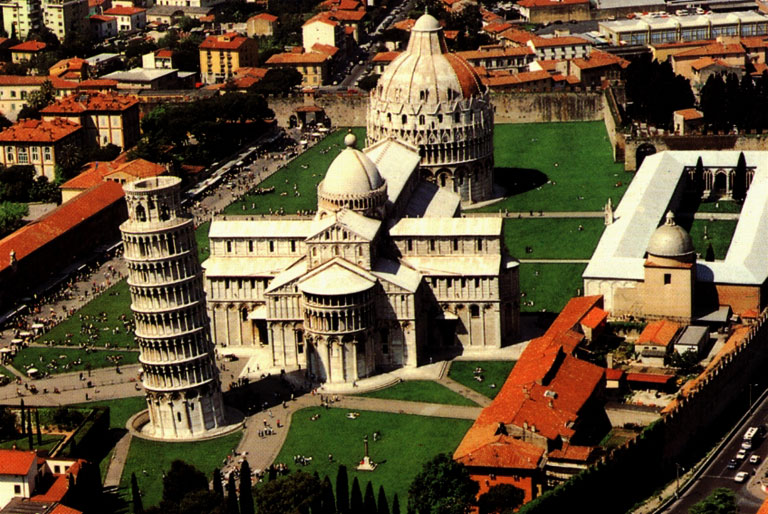Arte e cultura
Pisa and its Leaning Tower: the best known building worldwide


Here is another very ancient city that was first Greek, then Etruscan, Roman, Carolingian, and finally a glorious medieval republic which fell into the Medici family’s dominion after a long decline.
Pisa was the birthplace of the great Italian pre-Renaissance sculpture, thanks to the Apulian artist Nicola Pisano who, once he had moved here, began the great school which was then carried out by his son Giovanni and Arnolfo di Cambio. Between the end of the 13th century and the whole 14th century, Pisa was one of the most active and important Italian artistic centre. A proof of this is the impressive complex of buildings composed by the Cathedral, the Baptistery, the Leaning Tower or Bell Tower and the adjacent Graveyard that, with their solitude, form one of the most solemn and enchanting spots of Italy.
We cannot even attempt to list all the wonderful works of art flourishing here: the powerful bronze Doors by Bonanno (end of the 12th century), the Pulpit by Giovanni Pisano (1310) in the Cathedral, the mosaics, the paintings by Cimabue, Andrea del Sarto, Beccafumi, Sodoma, the choir inlays, the Tomb that Tino da Camiano sculpted for the emperor Arrigo VII, and the incredible collection of Greek, Roman and medieval sculptures placed on the four sides of the Graveyard, under an embellishment of medieval paintings… the sequence of marvels ends up on the background of an intact environment.
Visit the Cathedral and the surrounding buildings in Piazza dei Miracoli, then walk along via Santa Maria up to the Arno river, where there is the church of Santa Cecilia, next to the 16th-century Palazzo Reale, which is flanked by the Lungarno and, before reaching the Citadel, get onto the Ponte Solferino bridge and walk along the opposite Lungarno to the church of San Paolo a ripa d’Arno, whose Romanesque façade recalls that of the Cathedral, with wonderful sculptures. Then go back to the Lungarno and, after going past the bridge, you will find the refined church of Santa Maria della Spina, a gem of the Pisan Gothic. Walk along the Lungarno up to the Ponte di Mezzo, among wonderful ancient palaces, and go past the 17th -century Loggia dei Bianchi and, through via San Martino, reach the ancient octagonal and charming church of Santo Sepolcro (12th-century). Going ahead, you find yourself in the antique Arabic merchants’ neighbourhood, where you can see the huge and wonderfully painted church of San Martino.
From here you can go back to the Arno, cross it through the Ponte della Fortezza – with a wonderful view on all the Lungarnos - and reach the Medicean Lungarno, where there is the National Museum, with a very important collection of paintings (by Angelico, Masaccio, Signorelli, Gentile da Fabriano, Sodoma, and a magnificent group of primitive works) and Greek, Roman, medieval and Renaissance sculptures. Through via Santa Marta, you can reach the church of San Francesco (inside, you find some frescos by Taddeo Gaddi and Nicolò and Pietro Gerini) from which you can reach Santa Caterina, a charming 13th-century cuspidate church whose upper part was completed in the 14th century.
events
-
20September
Picasso and Spanish Modernity From 20th September 2014 to 25th January 2015 -
29October
The Chamber Musicians of “Maggio Musicale Fiorentino” 29th October 2014 -
13November
Women as Protagonists of the 20th Century from 13rd November 2013
